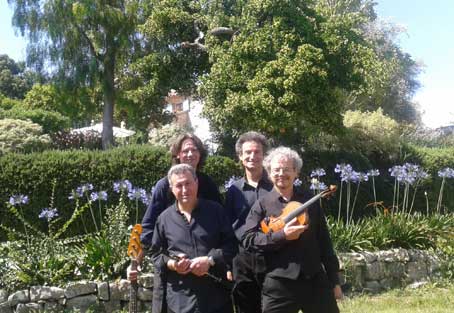
London-based Klezmer band * Jewish wedding band * bar mitzvah band
There are four main parts to the typical celebration; the ceremony (usually in the synagogue), the drinks reception, the meal, and the after- dinner dancing. You can choose to have live music at one or all of these.
The Ceremony:
For the ceremony itself, couples may ask for some informal music as the guests are gathering; this may be from only one or two musicians- perhaps fiddle, clarinet or accordion. There might then be a request for a specific tune for the procession of the bride to the Khupe (marriage canopy). This is often Sunrise Sunset, Erev Ba, Erev Shel Shoshanim, Eshet Chayil (Woman of Valour) or Baruch Chaba (Blessed is He). It has become traditional for a mobile phone to go off during the Sheva Brachot (Seven Blessings), though we can't guarantee the quality of this particular musical interlude. At the conclusion of the ceremony the groom breaks the glass and the musicians launch into a lively medley of horas, usually starting with Simentov Mazeltov (May good luck come to us); they will continue playing as guests disperse.
The Reception.
There is then frequently a frantic race as the band packs up and leaps for the car in order to get to the reception and set up again before the bride and groom. During the drinks reception there is usually light background music- a mixture of cocktail jazz and some klezmer tunes, adding to the atmosphere but not intruding too much over the chatting, nibbling and clinking of glasses
.
The Dinner.
As the guests go in for dinner they will yet again be surprised (or more likely not!) to find that the band has already set up there yet again, often by now expanded to a four or five-piece. Whilst the guests are eating, the band will play mellow jazz and latin numbers and perhaps some Russian, gypsy and other East European tunes. Some of the band may be persuaded to play "round the tables", playing gypsy, klezmer and romantic tunes. This is usually with fiddle and accordion; we've tried it with drums and double bass but the complaints then tend to outnumber the plaudits! Between courses, if there is space in the room the guests will often get up for a series of horas (circle dances). These can either be informal and improvised, or may be more organised (such as where the couple is lifted on chairs and paraded around the dancefloor). There may be a selection of bizarre line dances, bottle dances, tray dances and handkerchief dances, some traditional and dating back to ancient times;, ; others created on the spot with the help of an excess of champagne, and best quickly forgotten. If asked, we can provide someone to demonstrate and lead these dances.
The music for horas is usually a long medley of Israeli tunes- often starting with Hava Nagila or Siman Tov and including such favourites as Khosn Kale Mazeltov, Od Yishama, Tzena Tzena, Ufaratsa and Tzadik Katamar. The music may speed up towards the end until the dancers collapse exhausted on the floor. Order is then re-established and the guests return to the next course.
After-dinner dancing.
Finally, after the meal, the band, frequently transmuted yet again to include a drummer and a singer- will play for more "modern" dancing- rock and roll, sixties and seventies covers, latin and jazz. The more elderly guests will scowl, complain about the noise and drift towards the door whilst the youngsters get up and boogie like there's no tomorrow (and if they don't go easy on the free champagne, there won't be!)
ARRANGING MUSIC FOR YOUR CELEBRATION